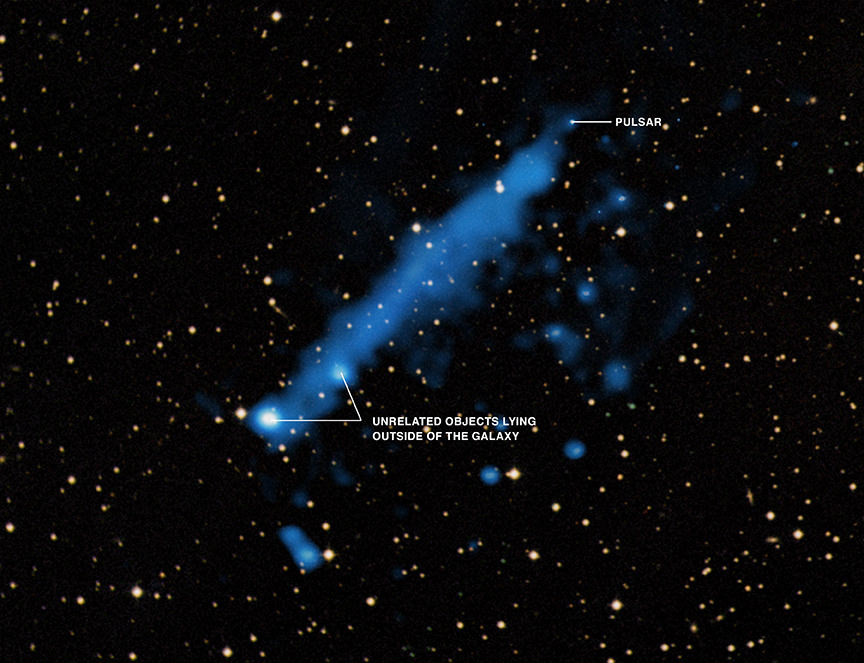Originally discovered by the Fermi Gamma Ray Space Telescope in 2009, Pulsar PSR J0357 had a bit of a surprise for astronomers when NASA’s Chandra X-ray Observatory turned an eye its way. Even though it might be 1,600 light years from Earth and half a million years old, it would appear this object has a cosmic sense of humor. Stretching across 4.2 light years is an enormous tail…
Viewable only at X-ray wavelengths, this incredible cosmic contrail is the longest ever associated with a so-called “rotation- powered” pulsar. Unlike other pulsars, J0357 gets its power from energy depletion as the spin rate decreases. But where did the plumage come from? According to the Chandra data, it may be an emission from energetic particles in the pulsar wind produced while turning around magnetic field lines. While artifacts of this type have been noted before, they’re classed as bow-shocks generated by the supersonic motion of pulsars through space. From there, the wind pulls the particles along behind it as the pulsar passes through interstellar gas.
But Pulsar PSR J0357 isn’t exactly fitting into a neat a tidy category…
According to data taken from Fermi, J0357 is only losing a small amount of energy as its spin rate slows. This means it shouldn’t be producing a particle wind of such proportions. Another anachronism is the placement of the bright portions of the tail – not anywhere near where bow-shocks are associated with pulsars.
“Further observations with Chandra could help test this bow-shock interpretation.” says the Chandra team. “If the pulsar is seen moving in the opposite direction from that of the tail, this would support the bow-shock idea.”
Original News Source: Chandra News.


For convenience, here’s the relevant paper:
Discovery of a faint X-ray counterpart and of a parsec-long X-ray tail for the middle-aged, gamma-ray only pulsar PSR J0357+3205
Interesting timing, as a paper on a probable pulsar with an X-ray tail was recently posted on arXiv: http://arxiv.org/PS_cache/arxiv/pdf/1107/1107.2832v1.pdf
While not positively identified as a pulsar, the source IGR J11014-6103 as observed by XMM-Newton and Swift satellites exhibits an X-ray “tail” of 4 arcmin length (compared to 9 arcmin for the tail described in this article) and seems consistent with a pulsar wind nebula similar to PSR J0357(discussed here) and the Guitar Nebula(PSR B2224+65). Observations with Chandra are proposed to resolve this object’s true nature.
While not having read the entire paper (thanks for the link Ivan), I did see some interesting tidbits. The paper notes that if J0357 is truly associated with the X-ray “tail” seen by Chandra, the pulsar would likely show “a large space velocity aligned with the tail, in a direction opposite to the tail extension.” The authors further mention that if this were the case, this would indicate the pulsar is moving almost parallel to the plane of the Galaxy, suggesting the object was born out of the Galactic plane (possibly, they note, from a “runaway” high-mass star).